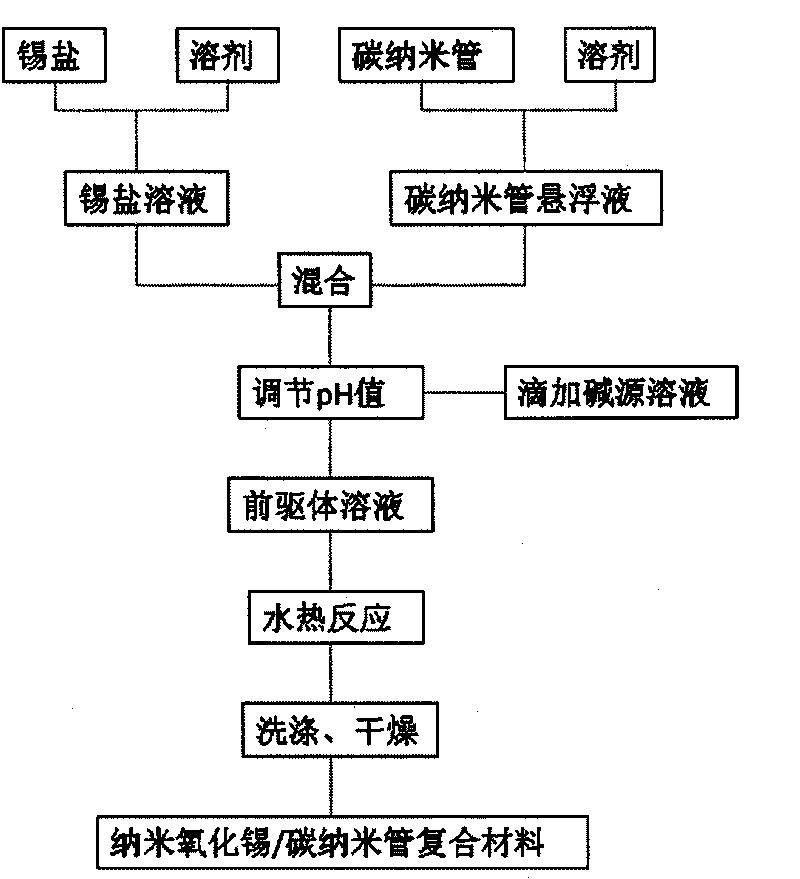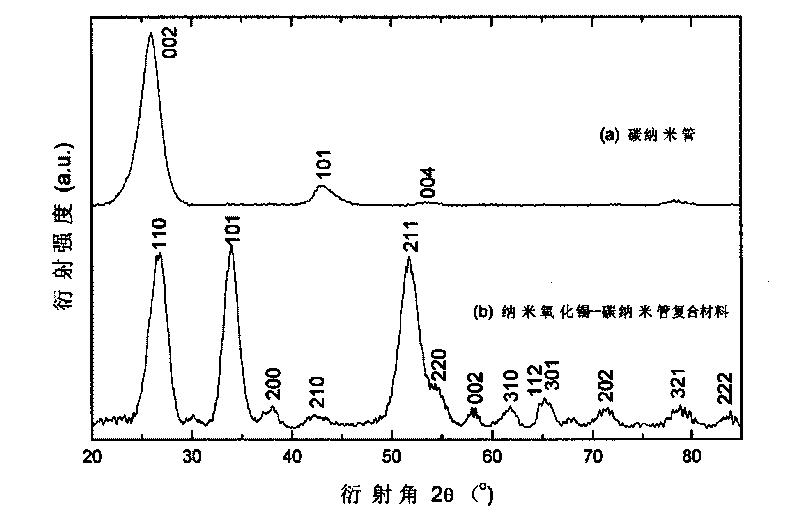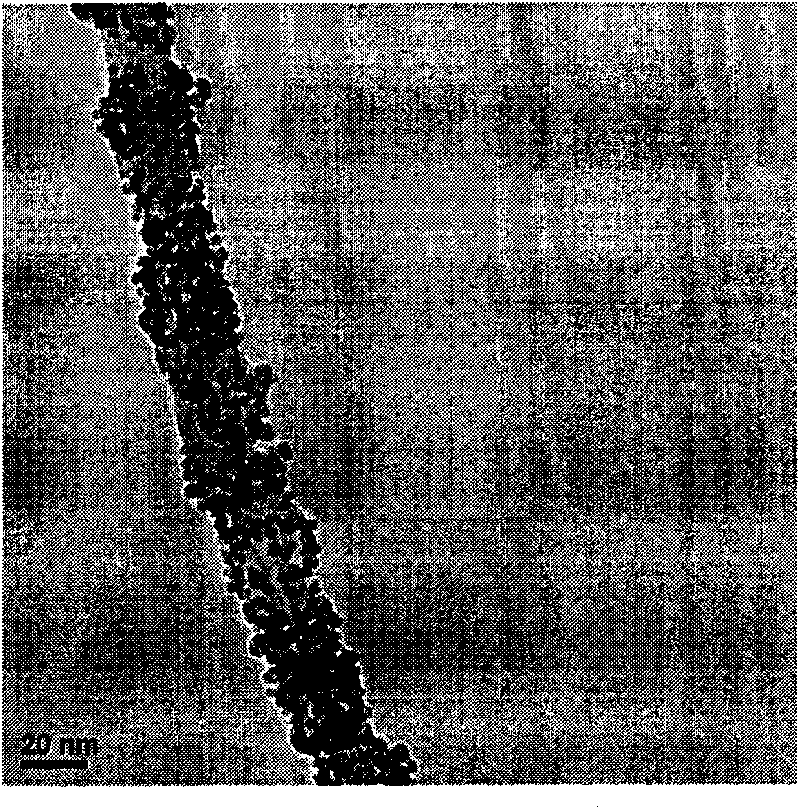In-situ synthesis method for nano tin dioxide/carbon nano tube composite material
A technology of nano-tin oxide and carbon nanotubes, applied in the direction of nanotechnology, nanotechnology, nanostructure manufacturing, etc., can solve the problems of large nano-SnO2 particle size, weak carbon nanotube binding, harsh preparation conditions, etc., and achieve short preparation cycle , good crystallization and uniform particle size
- Summary
- Abstract
- Description
- Claims
- Application Information
AI Technical Summary
Problems solved by technology
Method used
Image
Examples
specific Embodiment 1
[0033] Step 1, reflux the multi-walled carbon nanotubes with concentrated nitric acid at 120°C for 5 hours, then wash with deionized water several times until the pH of the washing solution = 7, and then dry at 60°C to obtain surface-functionalized multi-walled carbon nanotubes Tube;
[0034] Step 2, 1.354g of SnCl 2 .2H 2 O was dissolved in 20ml of absolute ethanol and stirred to form Sn 2+ Concentration is the stannous chloride solution of 0.3mol / L; According to the mass ratio (1:100) of carbon nanotubes and tin salt, the carbon nanotubes that acidification process is added in 20ml dehydrated alcohol ultrasonic dispersion 20min, form carbon suspension of nanotubes;
[0035] Step 3, while stirring, add the suspension of carbon nanotubes prepared in step 2 to the SnCl 2 solution, then continue to stir for 20 minutes, and then ultrasonic 10 minutes to form a mixed solution;
[0036] Step 4, while stirring, add an aqueous solution of NaOH with a concentration of 0.4 mol / L d...
specific Embodiment 2
[0040] Step 1, the multi-walled carbon nanotubes are treated with a mixed acid of concentrated nitric acid and concentrated sulfuric acid with a volume ratio of 1:3 at 120° C. for 5 hours, and then washed with deionized water for several times until the washing liquid is neutral, and then heated at 60 ℃ drying to obtain surface functionalized multi-walled carbon nanotubes.
[0041] Step 2, 1.354g of SnCl 2 2H 2 O was dissolved in 20ml of absolute ethanol and stirred to form Sn 2+ Concentration is the stannous chloride solution of 0.3mol / L; According to the weight ratio (1:100) of carbon nanotubes and tin salt, the carbon nanotubes that acidification process is added in 20ml dehydrated alcohol ultrasonic dispersion 20min, form carbon suspension of nanotubes;
[0042] Step 3, while stirring, add the suspension of carbon nanotubes prepared in step 2 to the SnCl 2 solution, then continue to stir for 20 minutes, and then ultrasonic 10 minutes to form a mixed solution;
[0043]...
specific Embodiment 3
[0047] Step 1, reflux the multi-walled carbon nanotubes with concentrated nitric acid at 120°C for 5 hours, then wash with deionized water several times until the pH of the washing solution is 7, and then dry at 60°C to obtain surface-functionalized multi-walled carbon nanotube.
[0048] Step 2, 1.354g of SnCl 2 2H 2 O was dissolved in 20ml of absolute ethanol and stirred to form Sn 2+ Concentration is the tin protochloride solution of 0.3mol / L; According to the weight ratio (5:100) of carbon nanotubes and tin salt, the carbon nanotubes that acidification process is added in 20ml dehydrated alcohol ultrasonic dispersion 20min, form carbon suspension of nanotubes;
[0049] Step 3, while stirring, add the suspension of carbon nanotubes prepared in step 2 to the SnCl 2 solution, then continue to stir for 20 minutes, and then ultrasonic 10 minutes to form a mixed solution;
[0050] Step 4, while stirring, add ammonia water with a mass concentration of 7% dropwise to the mixed...
PUM
| Property | Measurement | Unit |
|---|---|---|
| diameter | aaaaa | aaaaa |
| diameter | aaaaa | aaaaa |
Abstract
Description
Claims
Application Information
 Login to View More
Login to View More - R&D
- Intellectual Property
- Life Sciences
- Materials
- Tech Scout
- Unparalleled Data Quality
- Higher Quality Content
- 60% Fewer Hallucinations
Browse by: Latest US Patents, China's latest patents, Technical Efficacy Thesaurus, Application Domain, Technology Topic, Popular Technical Reports.
© 2025 PatSnap. All rights reserved.Legal|Privacy policy|Modern Slavery Act Transparency Statement|Sitemap|About US| Contact US: help@patsnap.com



